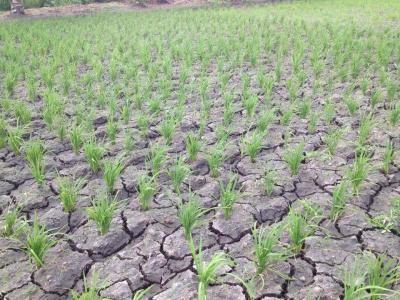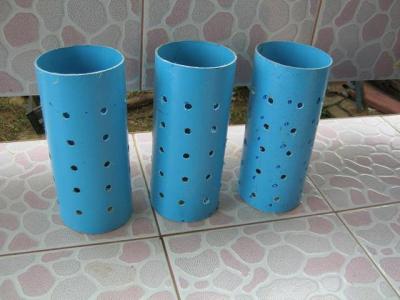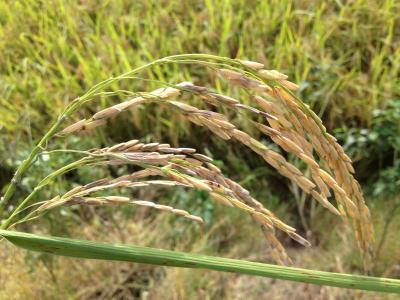- Why do Thai farmers work hard and are yet still poor?
- Why depression and helplessness are usually in the thoughts of Thai farmers?
- Is there a way to make any change?
These are questions that I kept asking to myself since to be a rice farmer would be my dream job!
Rice production captures my interest and that is why I did the master thesis about rice cropping patterns in Thailand. After that, I learned about the new interesting techniques of growing rice, which is the ‘System of Rice Intensification’ (SRI) and ‘Alternative Wet and Dry system’ (AWD), developed by World Bank and International Rice Research Institute (IRRI) respectively.
What is so special about these rice growing techniques?
SRI is an amazing cropping technique, where a farmer uses seedlings with 8 – 12 days old (2 leaves stage) to transplant only one seedling per hill (single seedling). A transplanting space between hills can be from 25 – 40 sq cm depending on soil’s fertility (high fertile soil, wider space). This technique can save more than half of seeds used in conventional methods. Besides, single seedling benefits a farmer in weed management because it is planted neatly and orderly, which makes it easy to get rid of weeds.
AWD irrigation system’s core concept is to irrigate the rice field to a water level of 5 cm and to then let it dry until water level drops to 15 cm below the soil surface, which takes about 7 – 10 days, before starting a new round, depending on soil and climate conditions. With this irrigation technique, the amount of water used in the rice field decreases about 40%; moreover, it enhances physical benefits from the environment to rice plants. One is that rice roots can absorb oxygen and nutrients directly through soil cracking, leading to root length density, and growth of roots and shoots. Strong and dense roots enhance rice plants’ resistance to storms and flooding. Furthermore, this system prevents and protects rice plants from pests, plant diseases and disorders because the rice field is kept wet and dry for most of the cropping period, which is not a preferable condition for these destroyers. Nevertheless, both techniques should be integrated with Thai conventional practices in order to find the most suitable pattern for each area.

Land plot search
The first plan that came to my mind after I got back to Thailand is to find a piece of land for rice cropping experiment. It was not such a good idea, I would say. After some months passed, I realized that searching for land is impossible especially for me, who grew up in the city, none of my friends or relatives is actually a farmer, plus my budget is tight. What I have is knowledge and no experience. How can a person like me, who has lived my entire life in an urban area of a capital city, grow rice?
Ten years ago, I might have spent months trying to find the right person to talk to. Today, Mark, Larry and Sergey have invented magical gadgets named Facebook and Google. All I have to do is just use it. Many thanks to them!
After typing some keywords, I found a guy, who initiated “the holiday farmer network” with the concept that everyone can be a farmer. What they have to do is invest time during the weekends or holidays. This sounded like the right place for me. I contacted him and joined the group, where I gained more knowledge, techniques, friends, and more importantly, inspiration. After a while, I started talking to more people until I met one a man, who found my idea interesting, but was not yet ready for change. He gave me a shot to test my idea in his rice field.
With an area of 1 rai (1 rai = 1600 sqm), my life as a farmer had begun.
The first important thing that I had to do was to make a field observation. This place is not far from the city. It takes just 1.5 hours by car. There is a small road separating the rice field and the owner’s house, which is full of fruits, vegetables and herbs. My piece is located at the end of the field, so I walked there to check the irrigation system and soil type. Both of them are perfect, only that I need to build a small paddy dike separating my rice field from the whole field.
Land preparation
The next step is land preparation; this typically involves plowing, harrowing, and leveling the field to make it suitable for crop establishment. Since I plan to test single seedling, transplantation, puddling and land leveling are a significant procedure. Most of rice fields in Thailand are flooded before tillage, referred to as puddling, which should be around 20 – 30 cm. depth. Effective land leveling will improve seedling transplantation and care, reduce time and water required to irrigate the field, and ensure more consistent distribution of water in the field.
To use the concept of AWD, I needed to measure the water level under the ground, so I made a tube from a PVC pipe (4 inches) with 40 holes (height 25 cm with 5 cm between each hole). How do I use it? First, I put this tube under the ground with around 5 cm showing above the soil surface. Then, remove the soil inside the tube, so that water can flow in and out the tube through the small holes. In this way, the water level under the ground can be seen easily. For transplanting space, my rice field is mostly clay soil, so an appropriate space that I applied is 30×30 cm., which is also a suitable space for me and my workers to walk in the field.

When the land is dry, weed can grow very fast. Since this is a chemical-free farm, I use rotary weedier; labor-saving weed management tool, to get rid of and control weeds in my rice field. If you still have no idea what it looks like and how it works, please, picture a lawn mower without the engine, and in a mop-shape. The process is very simple. It is similar to mopping the floor, but this time is to wiping weeds in the rice field. This way is not only an environmentally friendly method, but also a good way for exercising.
Harvesting
A cropping period depends on paddy seeds. The optimum age is around 90 – 120 days. The rice seed that I used is suitable for wet season, and it takes around 112 days from seedling to harvesting period. After transplanting in July, the sparse seedlings grew slowly until my paddy was covered by bright green color. Two weeks passed, they turned to dark green. Around mid of October, my little rice field turns from dark green to deep gold. It is time to harvest. In the past, rice is normally harvested by hand, but it has changed to a labor-saving machine. However, I decided to go with the traditional way since my rice field is too small to apply a machine, plus I have planned to make this activity as a public event that connects city people especially new generation to work with local farmers where my rice field located.
However, this time was not the right moment to invite people to join harvesting activity because my rice field was unfortunately flooding. When I got the news, I rushed to the field on the next morning to rescue my rice plants. I was picturing how devastating it can be, but what I actually saw is that rice plants still stood firmly even though the water level rose up to one-third of the plant. This is a proof that SRI and AWD methods enhance the strength of rice’ roots and shoots. However, rice plant is not a water plant, so I together with 2 workers grabbed sickles and jumped into the field.
The steps of traditional harvesting are firstly bending over the rice plant, which contains several florescences or panicles (the terminal component of the rice tiller). Then, grabbing a group of rice stalks on one hand, and slicing with the sickle by the other hand. Since the water level was rising up while I was harvesting, not the all was harvested in time. It is only the half field that I could save. For the rest, I had to let it go.
After 4 days passed, rice stalks got dry enough to be threshed. This was also performed manually by using two sticks tied together with a rope (or can use hands) to grasp a bunch of stalks and to hit them on a large tarp to release the grains. Some places hire a thresher truck for labor-saving and time-saving purpose. Then, rice grains are collected in bags, and brought to the local village mill in order to remove the husk from the grains. Polishing and sacking are the last process of rice production. The total amount of rice grains that I got is about 450 kg, and around 200 kg after milling. Not that bad, but it did not meet my expectations. Well, I still have next crop to improve it.

Lessons learned
After the harvesting period passed, I had learned some lessons from my first rice cropping experiment. With this method, I needed hands to help in cropping processes especially transplanting, harvesting and processing since investing in machinery is too expensive for a small area like mine. However, it was not easy to find a worker to help me in the field. The attitude towards being a farmer is not well-accepted among young generation even if their parents have been working as a farmer for the entire life. Consequently, the number of young farmers is decreasing in many places including my area. The solution that came to my mind is to invite city people, who are interested in rice farming, to help me during transplanting and harvesting periods. Not only will they have the experience, but also organic rice grains.
Another important thing that I found is the attitude of local farmers. Most of them think that the new techniques consume a lot of time; moreover, they are familiar with the old way of flooding the rice field to control weeds. I would say that being different in a rural society possibly brings a trouble to a farmer. In Thai society especially in rural areas, people live their lives depending on each other. They have close relationship, and tremendously care about maintaining their relationship with others. Therefore, changing or breaking community’s belief and convention would make a crack in one relationship towards the others. A tangible example is when that farmer needs hands to help in the field such as harvesting; he/she might get refused by the neighbors. It is very challenging to be independent in the community.
In my case, I showed up as a city girl with zero experience in rice cropping, but with strong believe in SRI and AWD. Clearly, I received a negative attitude from local farmers, but I have proved that rice cropping is what I really love and want to make it best. Even though there are some mistakes and unpredictable situations happen, I would say that these two new techniques have proved to be an effective method of growing rice.
Now, I have all the answers to the questions that I had at the first place.
“Why do Thai farmers work hard and are yet still poor?”
– Because most of their income depends on rice price. Not many of them take a look at the production cost, which mainly comes from chemical pesticides and fertilizers, so they got stuck in debt.
“Why depression and helplessness are usually in the thoughts of Thai farmers?”
– Local farmers are smart, I would say, but they do not realize their potential. Although the new techniques make it easier for them to control all factors in the paddy field, they still are scared of changing from the conventional way to the new one. It looks too risky for them, which I totally can understand, especially if the household’s only income source is from rice cultivation.
“Is there a way to make any change?”
– As I stated at the beginning, SRI and AWD are wonderful techniques, but need to be adapted to local environment. The major obstacle is labor-intensiveness, which can be solved by connecting local farmers with city people. Lower costs of production are not the only benefit from this activity. Application of this approach also benefits social network building among farmers, as well as knowledge and experience exchange both of which are a high value gain.
Master’s of Science in Sustainable Development and International Marketing. Graduated with a B.A. in Economics, majoring in Business and Managerial Economics and minoring in Development Economics on the subject of rural development. Work experience in market planning and business strategies in advertising business, plus public relations and corporate social responsibility for companies and organizations. Specialization in cost-benefit analysis of agricultural and environmental projects. Now working as a program associate at Ashoka (Thailand); responsible for social projects evaluation and social impacts investment, while working in the rice fields as a weekend farmer.